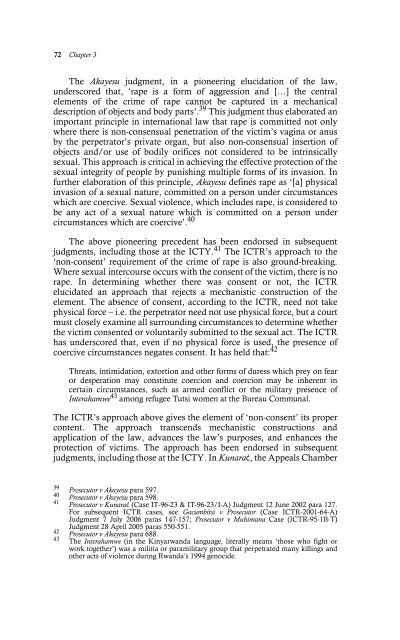Prosecuting International Crimes in Africa - PULP - University of ...
Prosecuting International Crimes in Africa - PULP - University of ...
Prosecuting International Crimes in Africa - PULP - University of ...
You also want an ePaper? Increase the reach of your titles
YUMPU automatically turns print PDFs into web optimized ePapers that Google loves.
72 Chapter 3<br />
The Akayesu judgment, <strong>in</strong> a pioneer<strong>in</strong>g elucidation <strong>of</strong> the law,<br />
underscored that, ‘rape is a form <strong>of</strong> aggression and […] the central<br />
elements <strong>of</strong> the crime <strong>of</strong> rape cannot be captured <strong>in</strong> a mechanical<br />
description <strong>of</strong> objects and body parts’. 39 This judgment thus elaborated an<br />
important pr<strong>in</strong>ciple <strong>in</strong> <strong>in</strong>ternational law that rape is committed not only<br />
where there is non-consensual penetration <strong>of</strong> the victim’s vag<strong>in</strong>a or anus<br />
by the perpetrator’s private organ, but also non-consensual <strong>in</strong>sertion <strong>of</strong><br />
objects and/or use <strong>of</strong> bodily orifices not considered to be <strong>in</strong>tr<strong>in</strong>sically<br />
sexual. This approach is critical <strong>in</strong> achiev<strong>in</strong>g the effective protection <strong>of</strong> the<br />
sexual <strong>in</strong>tegrity <strong>of</strong> people by punish<strong>in</strong>g multiple forms <strong>of</strong> its <strong>in</strong>vasion. In<br />
further elaboration <strong>of</strong> this pr<strong>in</strong>ciple, Akayesu def<strong>in</strong>es rape as ‘[a] physical<br />
<strong>in</strong>vasion <strong>of</strong> a sexual nature, committed on a person under circumstances<br />
which are coercive. Sexual violence, which <strong>in</strong>cludes rape, is considered to<br />
be any act <strong>of</strong> a sexual nature which is committed on a person under<br />
circumstances which are coercive’. 40<br />
The above pioneer<strong>in</strong>g precedent has been endorsed <strong>in</strong> subsequent<br />
judgments, <strong>in</strong>clud<strong>in</strong>g those at the ICTY. 41 The ICTR’s approach to the<br />
‘non-consent’ requirement <strong>of</strong> the crime <strong>of</strong> rape is also ground-break<strong>in</strong>g.<br />
Where sexual <strong>in</strong>tercourse occurs with the consent <strong>of</strong> the victim, there is no<br />
rape. In determ<strong>in</strong><strong>in</strong>g whether there was consent or not, the ICTR<br />
elucidated an approach that rejects a mechanistic construction <strong>of</strong> the<br />
element. The absence <strong>of</strong> consent, accord<strong>in</strong>g to the ICTR, need not take<br />
physical force – i.e. the perpetrator need not use physical force, but a court<br />
must closely exam<strong>in</strong>e all surround<strong>in</strong>g circumstances to determ<strong>in</strong>e whether<br />
the victim consented or voluntarily submitted to the sexual act. The ICTR<br />
has underscored that, even if no physical force is used, the presence <strong>of</strong><br />
coercive circumstances negates consent. It has held that: 42<br />
Threats, <strong>in</strong>timidation, extortion and other forms <strong>of</strong> duress which prey on fear<br />
or desperation may constitute coercion and coercion may be <strong>in</strong>herent <strong>in</strong><br />
certa<strong>in</strong> circumstances, such as armed conflict or the military presence <strong>of</strong><br />
Interahamwe 43 among refugee Tutsi women at the Bureau Communal.<br />
The ICTR’s approach above gives the element <strong>of</strong> ‘non-consent’ its proper<br />
content. The approach transcends mechanistic constructions and<br />
application <strong>of</strong> the law, advances the law’s purposes, and enhances the<br />
protection <strong>of</strong> victims. The approach has been endorsed <strong>in</strong> subsequent<br />
judgments, <strong>in</strong>clud<strong>in</strong>g those at the ICTY. In Kunarać, the Appeals Chamber<br />
39 Prosecutor v Akayesu para 597.<br />
40 Prosecutor v Akayesu para 598.<br />
41<br />
Prosecutor v Kunarać (Case IT-96-23 & IT-96-23/I-A) Judgment 12 June 2002 para 127.<br />
For subsequent ICTR cases, see Gacumbitsi v Prosecutor (Case ICTR-2001-64-A)<br />
Judgment 7 July 2006 paras 147-157; Prosecutor v Muhimana Case (ICTR-95-1B-T)<br />
Judgment 28 April 2005 paras 550-551.<br />
42 Prosecutor v Akayesu para 688.<br />
43 The Interahamwe (<strong>in</strong> the K<strong>in</strong>yarwanda language, literally means ‘those who fight or<br />
work together’) was a militia or paramilitary group that perpetrated many kill<strong>in</strong>gs and<br />
other acts <strong>of</strong> violence dur<strong>in</strong>g Rwanda’s 1994 genocide.

















